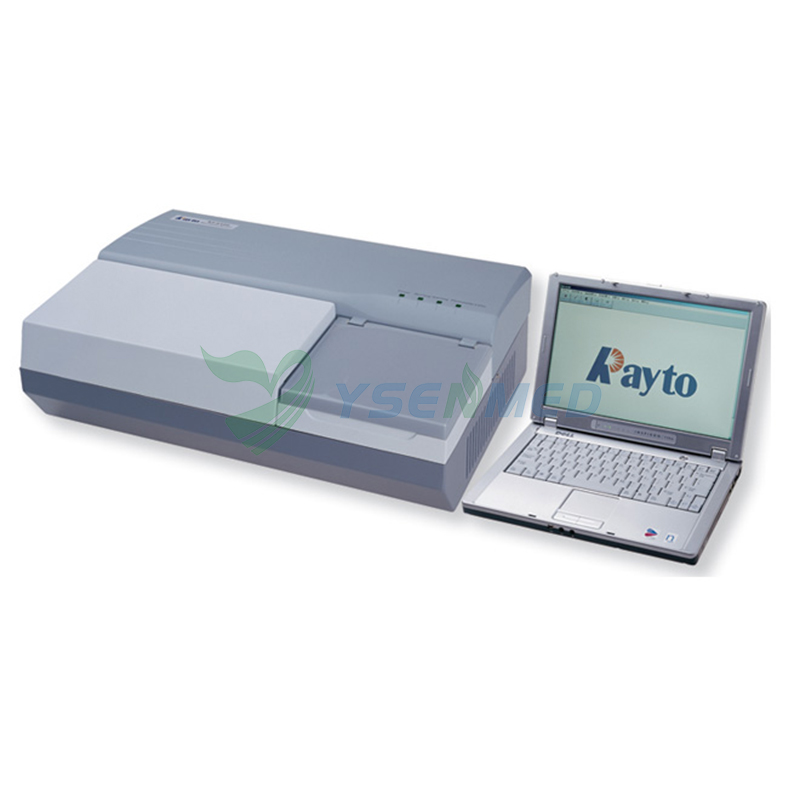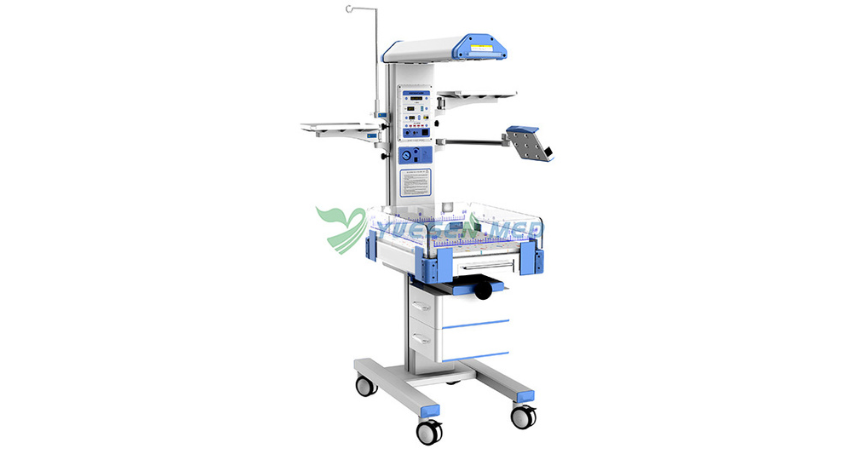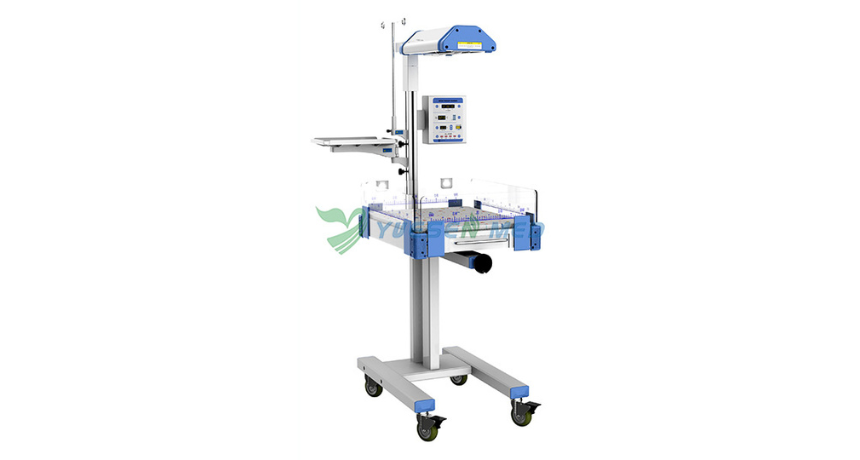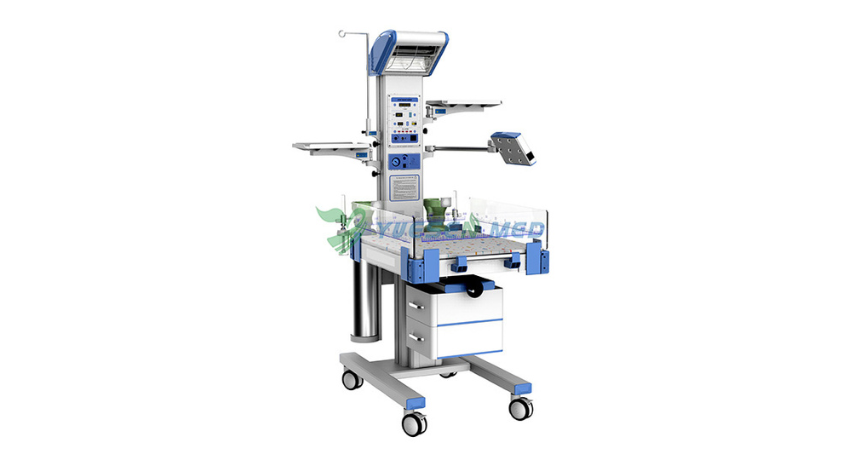Hot Products
YSX500D 50kW DR system set up and put into service in Cambodia.
YSENMED YSX500D 50kW digital x-ray system has been successfully set up and put into service in a hospital in Cambodia.
YSX056-PE serving as a vehicle-mounted x-ray in the Philippines
YSX056-PE 5.6kW portable x-ray unit has been adapted to fit on a truck, to provide mobile x-ray examination service for remote communities in the Philippines.
X Ray Machine To Zimbabwe
x ray machine, 50KW x ray machine
Microscope To Malawi
Achromatic objectives: 4X、10X、40X(S), 100X(S、Oil) Wide field eyepiece: WF10X(WF16X for option) Eyepiece head: Sliding binocular head inclined at 45° Stage: Double layer mechanical stage size 140X140mm, moving range 75X45mm Focusing: Coaxial coarse and
Choosing the Right ELISA Microplate Reader for Your Lab: What You Need to Know
Views : 2019
Update time : 2024-09-30 11:43:07
When it comes to running a successful lab, having the right equipment is crucial. One of the key players in your lab's arsenal is the ELISA microplate reader. But with so many options out there, how do you choose the right one? Don't worry; we've got you covered! In this article, we'll dive deep into everything you need to know about selecting the perfect ELISA microplate reader for your lab.

What is an ELISA Microplate Reader?
Before we jump into the nitty-gritty, let's start with the basics. An ELISA microplate reader is a specialized instrument used to measure the absorbance of samples in microplates. It's a vital tool for researchers conducting enzyme-linked immunosorbent assays (ELISAs), which are widely used in diagnostics, research, and quality control.
Why is Choosing the Right Reader Important?
Imagine trying to bake a cake without the right oven. You might end up with a gooey mess instead of a delicious treat! Similarly, using an unsuitable microplate reader can lead to inaccurate results, wasted time, and resources. Choosing the right reader ensures reliable data, which is essential for your research or clinical trials.
Key Features to Consider
1. Wavelength Range
One of the first things to consider is the wavelength range of the reader. Different assays require different wavelengths for optimal results. Make sure the reader can accommodate the specific wavelengths you need for your experiments.
2. Sensitivity and Dynamic Range
Sensitivity refers to the reader's ability to detect low concentrations of analytes, while dynamic range indicates the range of concentrations the reader can accurately measure. If your work involves detecting low levels of substances, look for a reader with high sensitivity and a broad dynamic range.
3. Speed of Reading
Time is often of the essence in a lab setting. Some readers can process multiple plates simultaneously, while others may take longer. Assess how many samples you typically run and choose a reader that meets your throughput needs.
4. Data Analysis Software
The best microplate readers come with user-friendly software that simplifies data analysis. Look for software that allows for easy export of data, statistical analysis, and graphical representation of results.
5. Ease of Use
Let's face it: nobody wants to spend hours deciphering complicated manuals. Choose a reader that is intuitive and easy to operate. This will save you time and reduce the likelihood of errors during testing.
Types of ELISA Microplate Readers
1. Single-Channel Readers
These are the most basic type of microplate readers. They measure one well at a time, making them slower but often more affordable. They're great for labs with low throughput.
2. Multi-Channel Readers
If you need to process large volumes of samples quickly, multi-channel readers are the way to go. They can measure multiple wells simultaneously, significantly speeding up the process.
3. Filter-Based Readers
These readers use optical filters to isolate specific wavelengths. They're versatile and can be used for a wide range of assays, but they may require additional filters for different wavelengths.
4. Monochromator-Based Readers
These are more advanced and allow for variable wavelength selection, making them suitable for a broader range of applications. They're typically more expensive but offer greater flexibility.
Budget Considerations
Let's talk money. ELISA microplate readers can vary greatly in price. While it might be tempting to go for the cheapest option, consider the long-term implications. Investing in a quality reader can save you money in the long run by providing accurate results and reducing the need for repeat tests.
Brand Reputation and Support
Not all brands are created equal. Do some research on the brands you're considering. Look for user reviews, warranty options, and customer support services. A reputable brand will often provide better after-sales service, which can be invaluable when you encounter issues.
Maintenance and Calibration
Just like any piece of equipment, ELISA microplate readers require regular maintenance and calibration to ensure accuracy. Check if the manufacturer provides guidelines for maintenance and whether they offer calibration services.
Additional Features to Look For
1. Temperature Control
Some assays are temperature-sensitive. If your work involves such assays, consider a reader with built-in temperature control to ensure consistent results.
2. Barcode Scanning
If you're dealing with a high volume of samples, a reader with barcode scanning can save you a ton of time and reduce errors in sample identification.
3. Connectivity Options
In today's digital age, connectivity is key. Look for a reader that offers USB, Ethernet, or Wi-Fi options for easy data transfer and integration with your lab's systems.
User Training and Support
Once you've chosen your microplate reader, proper training for your lab staff is essential. Ensure that the manufacturer or supplier offers training sessions to help your team get the most out of the equipment.
Common Mistakes to Avoid
1. Not Considering Future Needs
It's easy to focus on your current requirements, but what about the future? Consider potential growth or changes in your research focus that might necessitate a more advanced reader down the line.
2. Ignoring Reviews and Recommendations
Don't skip the research phase! User reviews and recommendations can provide valuable insights into the performance and reliability of different models.
3. Overlooking Compatibility with Assays
Make sure the reader you choose is compatible with the types of assays you plan to run. This can save you a lot of headaches later on.
Conclusion
Choosing the right ELISA microplate reader for your lab doesn't have to be a daunting task. By considering factors like wavelength range, sensitivity, speed, and ease of use, you can find a reader that meets your specific needs. Remember, investing in quality equipment is investing in the reliability of your research. So take your time, do your homework, and make an informed decision. With the right ELISA microplate reader in hand, you'll be well on your way to achieving accurate results and advancing your scientific endeavors. Happy researching!
FAQ
What factors should I consider when selecting an ELISA microplate reader?
When selecting an ELISA microplate reader, consider key factors such as the wavelength range, sensitivity, speed of reading, and data analysis software. It’s also important to evaluate the ease of use, maintenance requirements, and any additional features like temperature control or barcode scanning that may benefit your specific applications.
How does the wavelength range affect my ELISA results?
The wavelength range of a microplate reader is crucial because different assays require specific wavelengths for optimal detection. If the reader cannot accommodate the necessary wavelengths, it may lead to inaccurate measurements and unreliable results, impacting the validity of your research.
What is the difference between single-channel and multi-channel readers?
Single-channel readers measure one well at a time, making them suitable for low-throughput labs. In contrast, multi-channel readers can measure multiple wells simultaneously, significantly increasing the speed and efficiency of sample processing, which is ideal for high-throughput environments.

What is an ELISA Microplate Reader?
Before we jump into the nitty-gritty, let's start with the basics. An ELISA microplate reader is a specialized instrument used to measure the absorbance of samples in microplates. It's a vital tool for researchers conducting enzyme-linked immunosorbent assays (ELISAs), which are widely used in diagnostics, research, and quality control.
Why is Choosing the Right Reader Important?
Imagine trying to bake a cake without the right oven. You might end up with a gooey mess instead of a delicious treat! Similarly, using an unsuitable microplate reader can lead to inaccurate results, wasted time, and resources. Choosing the right reader ensures reliable data, which is essential for your research or clinical trials.
Key Features to Consider
1. Wavelength Range
One of the first things to consider is the wavelength range of the reader. Different assays require different wavelengths for optimal results. Make sure the reader can accommodate the specific wavelengths you need for your experiments.
2. Sensitivity and Dynamic Range
Sensitivity refers to the reader's ability to detect low concentrations of analytes, while dynamic range indicates the range of concentrations the reader can accurately measure. If your work involves detecting low levels of substances, look for a reader with high sensitivity and a broad dynamic range.
3. Speed of Reading
Time is often of the essence in a lab setting. Some readers can process multiple plates simultaneously, while others may take longer. Assess how many samples you typically run and choose a reader that meets your throughput needs.
4. Data Analysis Software
The best microplate readers come with user-friendly software that simplifies data analysis. Look for software that allows for easy export of data, statistical analysis, and graphical representation of results.
5. Ease of Use
Let's face it: nobody wants to spend hours deciphering complicated manuals. Choose a reader that is intuitive and easy to operate. This will save you time and reduce the likelihood of errors during testing.
Types of ELISA Microplate Readers
1. Single-Channel Readers
These are the most basic type of microplate readers. They measure one well at a time, making them slower but often more affordable. They're great for labs with low throughput.
2. Multi-Channel Readers
If you need to process large volumes of samples quickly, multi-channel readers are the way to go. They can measure multiple wells simultaneously, significantly speeding up the process.
3. Filter-Based Readers
These readers use optical filters to isolate specific wavelengths. They're versatile and can be used for a wide range of assays, but they may require additional filters for different wavelengths.
4. Monochromator-Based Readers
These are more advanced and allow for variable wavelength selection, making them suitable for a broader range of applications. They're typically more expensive but offer greater flexibility.
Budget Considerations
Let's talk money. ELISA microplate readers can vary greatly in price. While it might be tempting to go for the cheapest option, consider the long-term implications. Investing in a quality reader can save you money in the long run by providing accurate results and reducing the need for repeat tests.
Brand Reputation and Support
Not all brands are created equal. Do some research on the brands you're considering. Look for user reviews, warranty options, and customer support services. A reputable brand will often provide better after-sales service, which can be invaluable when you encounter issues.
Maintenance and Calibration
Just like any piece of equipment, ELISA microplate readers require regular maintenance and calibration to ensure accuracy. Check if the manufacturer provides guidelines for maintenance and whether they offer calibration services.
Additional Features to Look For
1. Temperature Control
Some assays are temperature-sensitive. If your work involves such assays, consider a reader with built-in temperature control to ensure consistent results.
2. Barcode Scanning
If you're dealing with a high volume of samples, a reader with barcode scanning can save you a ton of time and reduce errors in sample identification.
3. Connectivity Options
In today's digital age, connectivity is key. Look for a reader that offers USB, Ethernet, or Wi-Fi options for easy data transfer and integration with your lab's systems.
User Training and Support
Once you've chosen your microplate reader, proper training for your lab staff is essential. Ensure that the manufacturer or supplier offers training sessions to help your team get the most out of the equipment.
Common Mistakes to Avoid
1. Not Considering Future Needs
It's easy to focus on your current requirements, but what about the future? Consider potential growth or changes in your research focus that might necessitate a more advanced reader down the line.
2. Ignoring Reviews and Recommendations
Don't skip the research phase! User reviews and recommendations can provide valuable insights into the performance and reliability of different models.
3. Overlooking Compatibility with Assays
Make sure the reader you choose is compatible with the types of assays you plan to run. This can save you a lot of headaches later on.
Conclusion
Choosing the right ELISA microplate reader for your lab doesn't have to be a daunting task. By considering factors like wavelength range, sensitivity, speed, and ease of use, you can find a reader that meets your specific needs. Remember, investing in quality equipment is investing in the reliability of your research. So take your time, do your homework, and make an informed decision. With the right ELISA microplate reader in hand, you'll be well on your way to achieving accurate results and advancing your scientific endeavors. Happy researching!
FAQ
What factors should I consider when selecting an ELISA microplate reader?
When selecting an ELISA microplate reader, consider key factors such as the wavelength range, sensitivity, speed of reading, and data analysis software. It’s also important to evaluate the ease of use, maintenance requirements, and any additional features like temperature control or barcode scanning that may benefit your specific applications.
How does the wavelength range affect my ELISA results?
The wavelength range of a microplate reader is crucial because different assays require specific wavelengths for optimal detection. If the reader cannot accommodate the necessary wavelengths, it may lead to inaccurate measurements and unreliable results, impacting the validity of your research.
What is the difference between single-channel and multi-channel readers?
Single-channel readers measure one well at a time, making them suitable for low-throughput labs. In contrast, multi-channel readers can measure multiple wells simultaneously, significantly increasing the speed and efficiency of sample processing, which is ideal for high-throughput environments.
Related News
Read More >>
 What is the Difference Between Radiant Warmer and Phototherapy?
What is the Difference Between Radiant Warmer and Phototherapy?
Apr .19.2025
Radiant warmers and phototherapy are crucial in neonatal care, but they serve different purposes. Let's dive into the nitty-gritty of these two techniques and explore how they differ, and when each is appropriate.
 YSX056-PE portable digital x-ray unit set up in the Philippines
YSX056-PE portable digital x-ray unit set up in the Philippines
Apr .19.2025
YSX056-PE portable digital x-ray unit has been set up in a hospital in the Philippines and the good quality images please the doctors.
 Is an Infant Radiant Warmer Good for Babies' Health?
Is an Infant Radiant Warmer Good for Babies' Health?
Apr .13.2025
What exactly is the infant radiant warmer, and how does it contribute to a baby's health? Let's dive into this topic and explore the ins and outs of infant radiant warmers.
 What is an Infant Radiant Warmer?
What is an Infant Radiant Warmer?
Apr .12.2025
One of the unsung heroes in neonatal care is the infant radiant warmer. But what exactly is it? Let's dive into the world of infant care and explore the ins and outs of this vital device.



